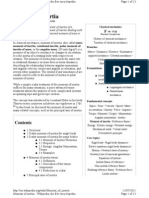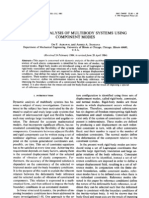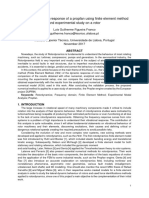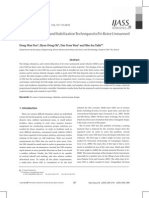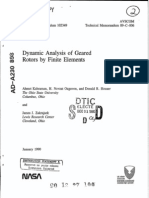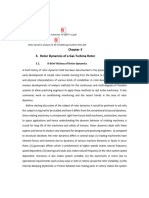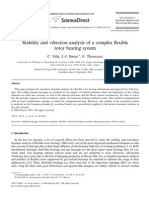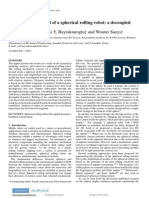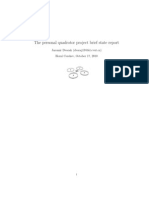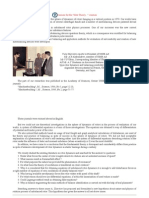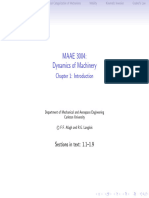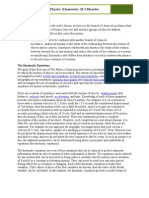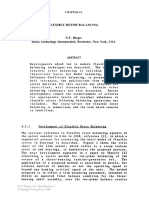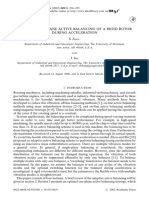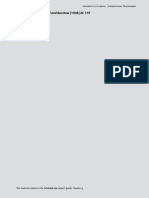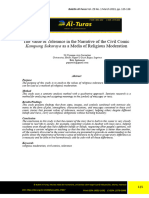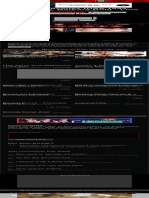Dynamic Behaviour of Rotating Machinery: 4.1 Rotors and Structures
Dynamic Behaviour of Rotating Machinery: 4.1 Rotors and Structures
Uploaded by
YASSERCopyright:
Available Formats
Dynamic Behaviour of Rotating Machinery: 4.1 Rotors and Structures
Dynamic Behaviour of Rotating Machinery: 4.1 Rotors and Structures
Uploaded by
YASSEROriginal Title
Copyright
Available Formats
Share this document
Did you find this document useful?
Is this content inappropriate?
Copyright:
Available Formats
Dynamic Behaviour of Rotating Machinery: 4.1 Rotors and Structures
Dynamic Behaviour of Rotating Machinery: 4.1 Rotors and Structures
Uploaded by
YASSERCopyright:
Available Formats
4
Dynamic Behaviour of Rotating
Machinery
4.1 Rotors and structures
The preceding chapters have been devoted to the study of the dynamic behaviour
of structures, i.e., of mechanical systems that are stationary with respect to an inertial
frame of reference, apart from the vibratory motion that is the object of the study.
Many machine elements, however, do not comply with this definition since, owing
to their rotational motion, it is not possible to define an inertial system of reference
in which the element is stationary.
The present section will be devoted to the study of the dynamic behaviour of rotors.
Following the ISO definition, a rotor is a body suspended through a set of cylindrical
hinges or bearings that allow it to rotate freely about an axis fixed in space. Trans-
mission shafts, parts of reciprocating machines that have only rotational motion and
many other rotating machine elements can then be considered rotors. If no reference
is made to the type of the supports or even to their actual existence, a space vehicle
or a celestial body that rotates about an axis whose direction in space is constant can
also be regarded as rotors, at least for some of the features of their behaviour. The
parts of the machine that do not rotate will be referred to with the general definition
of stator.
Some simplifying assumptions allowing the building of mathematical models that
are not too complex for the dynamic study of rotors must be stated. The equations
that describe the motion of even a simple rigid body in the tridimensional space are
actually quite complex, particularly when dealing with the rotational degrees of
freedom, and do not allow use of any linearized model. Once the reference frames
xyz and ~T\~ (the frrst inertial and the second fixed to the rigid body and coinciding
with its principal axes of inertia) are stated, the six equations of motion under the
action of the generic force F and moment M can be written in the form
G. Genta, Vibration of Structures and Machines
© Springer-Verlag New York, Inc. 1995
210 4. Dynamic Behaviour of Rotating Machinery
M~ =nr!~+nTP.~(J~-J'f})
{M'f} =D..!'f} +nf,n~(JCJ~) (4-1)
M~=n-l~+nA(J'f}-J~) .
The last three equations for the rotational degrees of freedom, which are the
well-known Euler equations, are clearly nonlinear in the angular velocity n.
However, some simplifications that allow the linearization of the equations related
to the rotational degrees of freedom can be made for the case of rotors. The rotor
has, in the undeformed configuration, a well-defmed and fixed rotation axis, which
coincides with one of the baricentrical principal axes of inertia, if the rotor is perfectly
balanced. Actually, this is true only approximately, but the unbalance, i.e., the
deviation from this ideal condition, is usually small. The displacement of the
rotational axis from its nominal position due to the deformations of the system is
also assumed to be small. The two assumptions of small unbalance and small
displacement allow the linearization of the equations of motion in a way that is
consistent with what has been seen for the case of the dynamics of structures where
similar small-displacement assumptions were required to obtain linear equations of
motion.
Some cases that, strictly speaking, could not be studied using the aforementioned
assumptions, can, nevertheless, be dealt with in the same way. Consider as an example
the rotor of an aircraft gas turbine during maneuvred flight. The direction of the axis
of the rotor changes continuously in time, and no small-angle assumption can be
considered for this motion. However, the motion of the rotor can be studied in a
reference frame that is fixed to the aircraft, provided that the motion of the latter can
be considered independent from the dynamic behaviour of the first and the related
inertia forced are added. This way of separating the problem into its dynamic and
quasi static parts is possible if the characteristic times of the different phenomena
under study are widely different. In the example above this is clearly the case if the
frequencies that characterize the motion of the rotor of the turbine with respect to
the aircraft are of several Hertz (periods of fractions of seconds), while the rotations
of the airframe have characteristic times of the order of several seconds. On the
contrary, the seismic actions on the rotor of a machine in a building can have fre-
quencies that are of the same order of magnitude as those that characterize the rotor
itself, and the problem may have to be studied without any uncoupling being possible.
Another common assumption is that of axial symmetry of the rotor. If this
assumption holds, the dynamic study is greatly simplified and a nonrotating reference
frame is usually also chosen for the study of rotor motions. If, on the contrary, the
rotor cannot be considered axially symmetrical, the study becomes very complicated,
unless an axial symmetry assumption can be made on the nonrotating parts of the
system. In the latter case a reference frame that rotates at the angular velocity of the
rotor can be used and simplified equations can be obtained. If both stator and rotor
are isotropic with respect to the rotation axis, particularly simple models can be
devised.
You might also like
- A Stepmother's MarchenDocument1,171 pagesA Stepmother's Marchengyorfiboroka73% (11)
- Rocky Horror Audience ScriptDocument61 pagesRocky Horror Audience ScriptWhitney Marie Wolf80% (5)
- Rotating Reference FrameDocument6 pagesRotating Reference FrameCalvin SullivanNo ratings yet
- 2 QuadDocument24 pages2 QuadBharat NarumanchiNo ratings yet
- (1988) - Whirling of Unsymmetrical Rotors, A Finite Element Approach Basen On Complex Co-Ordinates - GentaDocument27 pages(1988) - Whirling of Unsymmetrical Rotors, A Finite Element Approach Basen On Complex Co-Ordinates - GentaAgustín Erasmo Juárez MartínezNo ratings yet
- Rigid Rotor WikipediaDocument8 pagesRigid Rotor WikipediaAtropospNo ratings yet
- Argyris 1978Document51 pagesArgyris 1978A. Miguel EchegarayNo ratings yet
- SNUx Chapter 1Document8 pagesSNUx Chapter 1safasabaNo ratings yet
- Moment of InertiaDocument13 pagesMoment of InertiaRahmatullah RahmatNo ratings yet
- Intro Robot Kinematics 5Document25 pagesIntro Robot Kinematics 5Gnanesh PendliNo ratings yet
- EOM For Structures in Terms of Quasi CoordinatesDocument17 pagesEOM For Structures in Terms of Quasi CoordinatesVitor FinottoNo ratings yet
- TOM NOTESDocument24 pagesTOM NOTES1ds22me042No ratings yet
- Geometric Foundations of Motion and ControlDocument14 pagesGeometric Foundations of Motion and Controlnephren17No ratings yet
- Analytical Dynamics Chapter - 1Document69 pagesAnalytical Dynamics Chapter - 1TOLGA GüneşNo ratings yet
- Dynamic Analysis of Multibody Systems Using Component ModesDocument10 pagesDynamic Analysis of Multibody Systems Using Component ModesSree Harsha Reddy JangaNo ratings yet
- Moment of InertiaDocument16 pagesMoment of InertiaerkarnanNo ratings yet
- Rotational of Rigid Body (As)Document5 pagesRotational of Rigid Body (As)Amirul Syafiq KamalNo ratings yet
- Mech 315-Engineering Mechanics SyllabusDocument3 pagesMech 315-Engineering Mechanics SyllabuspicefeatiNo ratings yet
- Chaotic Vibration Analysis of Rotating, Flexible, Continuous Shaft-Disk System With A Rub-Impact Between The Disk and The Stator PDFDocument17 pagesChaotic Vibration Analysis of Rotating, Flexible, Continuous Shaft-Disk System With A Rub-Impact Between The Disk and The Stator PDFmohdsolihat1No ratings yet
- Rigid Body Dynamics - Wikipedia, The Free EncyclopediaDocument13 pagesRigid Body Dynamics - Wikipedia, The Free EncyclopediabmxengineeringNo ratings yet
- (1979) Dynamics of Rotationally Periodic StructuresDocument22 pages(1979) Dynamics of Rotationally Periodic Structuresupiop86No ratings yet
- ResumoDocument10 pagesResumovothanhbinh311099No ratings yet
- European Journal of Mechanics A/Solids: Qinkai Han, Fulei ChuDocument11 pagesEuropean Journal of Mechanics A/Solids: Qinkai Han, Fulei ChunilNo ratings yet
- Helicopter StabilityDocument13 pagesHelicopter Stabilitymanikandan_murugaiahNo ratings yet
- Dynamic Modeling and Stabilization Techniques For Tri-Rotor Unmanned Aerial VehiclesDocument8 pagesDynamic Modeling and Stabilization Techniques For Tri-Rotor Unmanned Aerial VehiclesBeatrice FiranNo ratings yet
- Dynamic Analysis of Geared Rotors by Finite ElementsDocument22 pagesDynamic Analysis of Geared Rotors by Finite ElementsVraj SenjaliyaNo ratings yet
- Finite Element Analysis of Simple Rotors IITDocument33 pagesFinite Element Analysis of Simple Rotors IITjonathan mayNo ratings yet
- RotordynamicsDocument35 pagesRotordynamicsadugna taddeseNo ratings yet
- piccione_paperDocument9 pagespiccione_paperdurgeshgupta.iitkNo ratings yet
- Mee307 1Document88 pagesMee307 1justicemr506No ratings yet
- Stability and Vibration Analysis of A Complex Exible Rotor Bearing SystemDocument18 pagesStability and Vibration Analysis of A Complex Exible Rotor Bearing SystemtejasckNo ratings yet
- Modeling and Control of A Spherical Rolling Robot A Decoupled Dynamics ApproachDocument10 pagesModeling and Control of A Spherical Rolling Robot A Decoupled Dynamics ApproachSteve HoNo ratings yet
- A Novel Quaternion Integration Approach For Describing The Behaviour of Non-Spherical ParticlesDocument19 pagesA Novel Quaternion Integration Approach For Describing The Behaviour of Non-Spherical ParticlesperosuttoneNo ratings yet
- Beam VibrationDocument20 pagesBeam Vibrationhmsedighi459No ratings yet
- Polar Moment of InertiaDocument3 pagesPolar Moment of Inertiaanil basnet100% (2)
- The Project Gutenberg Ebook: 1Document20 pagesThe Project Gutenberg Ebook: 1Gutenberg.orgNo ratings yet
- Investigation of Nonlinear Free Vibration Analysis and Critical Speeds of Lightweight Rotor Bearing SystemDocument24 pagesInvestigation of Nonlinear Free Vibration Analysis and Critical Speeds of Lightweight Rotor Bearing SystemPravesh S NairNo ratings yet
- Mechanics 2Document261 pagesMechanics 2Undras NeaguNo ratings yet
- Preared By: Dr. J. N. KERAITA: Emg 2404: Mechanics of Machines IiiDocument9 pagesPreared By: Dr. J. N. KERAITA: Emg 2404: Mechanics of Machines IiiMuthoka VincentNo ratings yet
- The Personal Quadrotor Project Brief State Report: Jaromir Dvorak (Dvoraj13@fel - Cvut.cz) Horn I Cerekev, October 17, 2010Document14 pagesThe Personal Quadrotor Project Brief State Report: Jaromir Dvorak (Dvoraj13@fel - Cvut.cz) Horn I Cerekev, October 17, 2010Hashem Mohamed HashemNo ratings yet
- E103 - AgustinDocument20 pagesE103 - AgustinSeth Jarl G. AgustinNo ratings yet
- A Unified Approach For Motion and Force Control of Robot Manipulators - The Operational Space Formulation, Oussama KhatibDocument11 pagesA Unified Approach For Motion and Force Control of Robot Manipulators - The Operational Space Formulation, Oussama KhatibtejswrpNo ratings yet
- Iare em Lecture Notes 2 PDFDocument188 pagesIare em Lecture Notes 2 PDFvanajaNo ratings yet
- A Gyroscope Is A Rotating Mass That Operates On The Principle ofDocument7 pagesA Gyroscope Is A Rotating Mass That Operates On The Principle ofdwijenderNo ratings yet
- Quadrotor Equations of MotionDocument4 pagesQuadrotor Equations of MotionKaran ChawlaNo ratings yet
- Aerial Robotics Lecture 2C - 4 Quadrotor Equations of MotionDocument4 pagesAerial Robotics Lecture 2C - 4 Quadrotor Equations of MotionIain McCullochNo ratings yet
- Reasons For The "New Theory... " CreationDocument18 pagesReasons For The "New Theory... " CreationA.BNo ratings yet
- Gimbal Lock Submitted VersionDocument29 pagesGimbal Lock Submitted Versionmuhamad otongNo ratings yet
- Kom Unit-IDocument18 pagesKom Unit-IRamanathan DuraiNo ratings yet
- Crank and Slotted Lever Quick Return (Rev2)Document9 pagesCrank and Slotted Lever Quick Return (Rev2)Vipin YadavNo ratings yet
- KOM-1 2 MarksDocument64 pagesKOM-1 2 MarksrajeshNo ratings yet
- BTM3134 Week 1 IntroductionDocument19 pagesBTM3134 Week 1 IntroductionAswaja313No ratings yet
- Chapter - 1 HandoutDocument28 pagesChapter - 1 HandoutnourheziNo ratings yet
- High Speed Balancing of Rotors With Overhangs When Is Overhang Likely To Cause ProblemsDocument17 pagesHigh Speed Balancing of Rotors With Overhangs When Is Overhang Likely To Cause ProblemsBoze SoldoNo ratings yet
- KinematicsDocument28 pagesKinematicsM J RhoadesNo ratings yet
- Handbook of Turbomachinery, Second Edition PDFDocument67 pagesHandbook of Turbomachinery, Second Edition PDFitaryNo ratings yet
- Modeling of Complex Systems: Application to Aeronautical DynamicsFrom EverandModeling of Complex Systems: Application to Aeronautical DynamicsNo ratings yet
- Flexible Rotor Balancing: N. F. Rieger (Ed.), Rotordynamics 2 © Springer-Verlag Wien 1988Document2 pagesFlexible Rotor Balancing: N. F. Rieger (Ed.), Rotordynamics 2 © Springer-Verlag Wien 1988YASSERNo ratings yet
- Rotor Balancing in TurbochargersDocument2 pagesRotor Balancing in TurbochargersYASSERNo ratings yet
- Journal of Sound and Vibration (1997) 208 (4), 656-663: Optimal Two-Plane Balance of Rigid Rotors L. J. EDocument8 pagesJournal of Sound and Vibration (1997) 208 (4), 656-663: Optimal Two-Plane Balance of Rigid Rotors L. J. EYASSERNo ratings yet
- Rotor Balancing: 28.1 General ConsiderationsDocument2 pagesRotor Balancing: 28.1 General ConsiderationsYASSERNo ratings yet
- Principles of Balancing and of Balancing Machines: N. F. Rieger (Ed.), Rotordynamics 2 © Springer-Verlag Wien 1988Document2 pagesPrinciples of Balancing and of Balancing Machines: N. F. Rieger (Ed.), Rotordynamics 2 © Springer-Verlag Wien 1988YASSERNo ratings yet
- Letters To The Editor: Optimal One-Plane Active Balancing of A Rigid Rotor During AccelerationDocument10 pagesLetters To The Editor: Optimal One-Plane Active Balancing of A Rigid Rotor During AccelerationYASSERNo ratings yet
- HydridesDocument2 pagesHydridesLeyre GonzálezNo ratings yet
- Akbar and BirbalDocument11 pagesAkbar and BirbalAnurag SrivastavaNo ratings yet
- Save You by Matthew Perryman JonesDocument2 pagesSave You by Matthew Perryman JonesIñigo Escalante100% (1)
- Wilhelm Reich, M.D. Microfilm Collection - Table of ContentsDocument14 pagesWilhelm Reich, M.D. Microfilm Collection - Table of ContentsWilhelm Reich Ghost100% (3)
- House Rules PDFDocument9 pagesHouse Rules PDFcalebrus44No ratings yet
- Constitutional Law-1Document105 pagesConstitutional Law-1Fadhil Mnoche100% (1)
- Zeta Macedonia: Vermont, USADocument3 pagesZeta Macedonia: Vermont, USAwaleexasNo ratings yet
- Form 1 Lesson 24 ListeningDocument2 pagesForm 1 Lesson 24 Listeninga multifandom fangirlNo ratings yet
- Retirement SriptDocument4 pagesRetirement SriptMaria Danica UangagNo ratings yet
- Budgeting and Budgetary Control As The Metric For Corporate PerformanceDocument33 pagesBudgeting and Budgetary Control As The Metric For Corporate PerformanceLê Ly NguyễnNo ratings yet
- RvIreland and Burstow - 1998Document2 pagesRvIreland and Burstow - 1998Allisha BowenNo ratings yet
- Media Law ProjectDocument7 pagesMedia Law ProjectArchita AgrawalNo ratings yet
- Too and Enough: This Chair Is Too SoftDocument2 pagesToo and Enough: This Chair Is Too SoftLinh ChuNo ratings yet
- Q1 LE Science4 Lesson7 Week-7Document12 pagesQ1 LE Science4 Lesson7 Week-7Carolyn CarolNo ratings yet
- Full Thesis SMIS 2018 19Document50 pagesFull Thesis SMIS 2018 19Jomar RebuladoNo ratings yet
- Biology Investigatory ProjectDocument20 pagesBiology Investigatory Projectrajeev dehariyaNo ratings yet
- FPM N8 SKAr 24 OD75 I5 BX Vhi H8 V FQVBLo HL 4 NT Q2 NTDocument14 pagesFPM N8 SKAr 24 OD75 I5 BX Vhi H8 V FQVBLo HL 4 NT Q2 NTMelalung CreatorNo ratings yet
- LC Medical 2Document17 pagesLC Medical 2Kharisma Wildan FuadiNo ratings yet
- Gas Gangrene: Kimberlee Hobizal DPM, Mha FacfasDocument36 pagesGas Gangrene: Kimberlee Hobizal DPM, Mha FacfaswhidiNo ratings yet
- Behind The Scenes (USA 1994, Asia Carrera, BarbarDocument1 pageBehind The Scenes (USA 1994, Asia Carrera, BarbarvierjsNo ratings yet
- 2 ACFN 623 Advanced Cost and Management Accounting Assignment 2Document7 pages2 ACFN 623 Advanced Cost and Management Accounting Assignment 2Ali Mohammed0% (1)
- 05 - Human Eye & The Colourful WorldDocument26 pages05 - Human Eye & The Colourful WorldAmogh Suman100% (2)
- Report OnDocument31 pagesReport OnzehadNo ratings yet
- S Mech & FDocument31 pagesS Mech & FVignesh RajendranNo ratings yet
- Rasdas vs. EstenorDocument5 pagesRasdas vs. EstenorHei Nah MontanaNo ratings yet
- The Merchant of Venice SUMMARYDocument26 pagesThe Merchant of Venice SUMMARYDeh TavernitiNo ratings yet
- Chapter - 04 Opportunity Analysis, Market Segmentation, Market TargetingDocument25 pagesChapter - 04 Opportunity Analysis, Market Segmentation, Market TargetingKJ VillNo ratings yet
- Latihan Inisiasi 3: State Whether The Underlined Word(s) Is (Are), ,, ,, ,,, orDocument3 pagesLatihan Inisiasi 3: State Whether The Underlined Word(s) Is (Are), ,, ,, ,,, orAdam RizkyNo ratings yet








